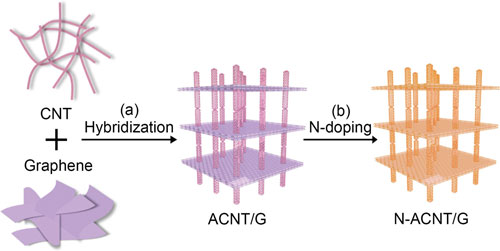| Posted: Sep 12, 2014 | |
Aligned carbon nanotube/graphene sandwiches for high-rate lithium-sulfur batteries |
|
| (Nanowerk Spotlight) Sp2-bonded carbon nanomaterials – such as carbon nanotubes (CNTs) and graphene – have attracted enormous research interest over the past decades. Due to their superior intrinsic physical properties, such as mechanical strength, electrical and thermal conductivity, these nanocarbons find numerous applications in areas such as catalysis, energy storage or nanocomposites. In addition to these intrinsic physical properties, what makes these materials so attractive are their tunable chemical characters, such as functional groups, doping, and surface modification. | |
| However, the demonstration of their intrinsic physical properties and performances in as-fabricated materials and practical devices has been suffering from the self-aggregation and re-stacking of nanocarbon materials due to strong van der Waals interactions. This prevents the full utilization of the active sites for catalytic reactions. | |
| Researchers consider the rational combination of CNTs and graphene into three-dimensional (3D) hybrids an effective route to amplify the inherent physical properties at the macroscale. From post-treatment methods to in situ growth, various strategies have been explored to fabricate such CNTs/graphene hybrids. Most of these approaches, though, still require barrier layers, which hinders the full demonstration of the excellent properties of these hybrid materials. | |
| By in situ nitrogen doping and structural hybridization of carbon nanotubes and graphene, a team from Tsinghua University, led by professors Qiang Zhang and Fei Wei, have now successfully fabricated nitrogen-doped aligned carbon nanotube/graphene (N-ACNT/G) sandwiches. In this work, aligned CNTs and graphene layers were anchored to each other, constructing a sandwich-like hierarchical architecture with efficient 3D electron transfer pathways and ion diffusion channels. | |
| The researchers have published their findings in Advanced Materials ("Nitrogen-Doped Aligned Carbon Nanotube/Graphene Sandwiches: Facile Catalytic Growth on Bifunctional Natural Catalysts and Their Applications as Scaffolds for High-Rate Lithium-Sulfur Batteries"). | |
 |
|
| Conceptual scheme of the design of N-ACNT/G hybrids with graphene and aligned CNTs as building blocks. (a) Structural hybridization of aligned CNTs and graphene via catalytic growth on bifunctional natural catalysts; (b) In situ nitrogen doping for moderate chemical modification of the carbon scaffolds. (Reprinted with permission by Wiley-VCH Verlag) | |
| "We used lamellar natural materials impregnated with metal nanoparticles as bifunctional catalysts and employed a two-step chemical vapor deposition (CVD) process that we devised to fabricate our novel composite," Dr. Qiang Zhang, an associate professor at the Department of Chemical Engineering at Tsinghua University, explains to Nanowerk. "The nanoparticles catalyzed the intercalation of aligned CNTs into the interlayer spaces of the layered catalyst via a low-temperature CVD, and sequentially the lamellar flakes served as a uniform substrate for the graphene deposition at the bottom of aligned CNTs through a high-temperature CVD. Simultaneously, we introduced NH3 during the CVD growth for the incorporation of nitrogen atoms into the carbon framework." | |
| High-quality aligned CNTs and graphene were separately grown on the nanoparticles and lamellar flakes at low- and high-temperature CVD, and vertically connected to each other in long-range periodicity. | |
| The result is a sandwich-like structure with 3D electron transfer pathways, interconnected ion diffusion channels, and interfacial affinity and electrochemical activity, which are essential and favorable for high-rate lithium-sulfur (Li-S) batteries. | |
| Li-S batteries are among the most promising candidates for next-generation power sources, due to a high theoretical energy density of 2600 Wh kg-1, the natural abundance of sulfur, and because they are considered environment friendly. | |
| So far, though, the unsatisfactory performance metrics – power capability and cyclic stability – have hampered their use in practical applications. | |
| Making use of the benefits of graphene for batteries, the team from Tsinghua used their novel N-ACNT/G sandwiches as cathode materials, they were able to demonstrate greatly enhanced cyclic and rate performances: High reversible capacities of 1152 mAh g-1 and 770 mAh g-1 were available at discharge rates of 1.0 and 5.0 C. A high capacity of 880 mAh g-1 can be maintained after 80 cycles at a current density of 1.0 C, which was about 65% higher than that of aligned CNTs. | |
| "Our high-performance Li-S battery capitalizes on the synergy brought by the structural hybridization of CNTs and graphene, and the interfacial modulation induced by nitrogen doping," notes Zhang. "The seamless junction of CVD-grown aligned CNTs and graphene provides rapid electron transfer and mechanical robustness. The 3D interconnected mesoporous space gives rise to easy penetration and diffusion of electrolytes. In addition, the nitrogen-modified interfaces enhance the interfacial affinity for efficient confinement and utilization of sulfur and polysulfides." | |
| In the future, the scientists hope to precisely control the hierarchical structure and chemical modification of N-ACNT/G sandwiches for various potential applications in the area of nanocomposite materials, energy storage, environmental protection, electronic devices, as well as healthcare. | |
| As Zhang points out, the design concept and fabrication strategy for N-ACNT/G sandwich are instructive and generally propagable. It also opens up fresh perspectives to advanced hierarchical nanostructures through 3D topological nanosystems and interfacial modifications. | |
 By
Michael
Berger
– Michael is author of three books by the Royal Society of Chemistry:
Nano-Society: Pushing the Boundaries of Technology,
Nanotechnology: The Future is Tiny, and
Nanoengineering: The Skills and Tools Making Technology Invisible
Copyright ©
Nanowerk LLC
By
Michael
Berger
– Michael is author of three books by the Royal Society of Chemistry:
Nano-Society: Pushing the Boundaries of Technology,
Nanotechnology: The Future is Tiny, and
Nanoengineering: The Skills and Tools Making Technology Invisible
Copyright ©
Nanowerk LLC
|
|
|
Become a Spotlight guest author! Join our large and growing group of guest contributors. Have you just published a scientific paper or have other exciting developments to share with the nanotechnology community? Here is how to publish on nanowerk.com. |
|
